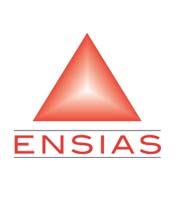- Accueil
-
L'Ecole
-
FORMATIONS
-
FORMATION INGENIEUR
-
Nouvelles filières offertes
- Ingénierie Intelligence Artificielle (2IA)
- Smart Supply Chain & Logistics (2SCL)
- Business Intelligence & Analytics (BI&A)
- Cybersécurité, Cloud et Informatique Mobile (CSCC)
- Data and Software Sciences (D2S)
- Génie de la Data (GD)
- Génie Logiciel (GL)
- Ingénierie Digitale pour la Finance (IDF)
- Smart System Engineering (SSE)
- REGLEMENT DES ETUDES DE L’ENSIAS CYCLE INGENIEUR
-
Nouvelles filières offertes
-
FORMATION INGENIEUR
- FORMATION CONTINUE
-
Recherche
- INTERNATIONAL
- ENTREPRISES
- VIE ESTUDIANTINE
- BIBLIOTHEQUE
LES DERNIÈRES INFORMATIONS
Container stacking problem - Mathematic model and resolution
| Titre | Container stacking problem - Mathematic model and resolution |
| Publication Type | Conference Paper |
| Year of Publication | 2014 |
| Authors | Razouk, Ca, Benadada, Yb, Boukachour, Jc |
| Conference Name | ILS 2014 - 5th International Conference on Information Systems, Logistics and Supply Chain |
| Abstract | Terminals are the intersection point of the different transportation modes such a s: Marine, Road, rail, so it has a crucial role in optimizing the flow of containers. Efficient container handling at terminals is important in reducing transportation costs an d keeping shipping schedules [Henesey 2008]. In this paper, we will present different container terminals problems which be divide d on three level (strategic, Tactics, operational), the composition of a container terminal, and then we will introduce and resolve the container stacking problem (CSP) in the storage yards of terminals. We present the mathematical formulation to the CSP as a general modelization including the leave time of each container, the type of the storage goods and their weight. Which will be enriching later either by the problems related to the storage yard such as rehandling problems, interference between yard cranes or by other problems related to the other component of a container terminal such as internal transportation, loading/unloadin g containers from vessel, berth allocation. Those problems are related to all the resources in terminal operations, including quay cranes, yard cranes, storage space, an d terminals trucks. We try to define the different component on the terminal basing to Steenken and al [Steenken 04], Stahlbock and Vob [Stahlbock 08] and Yuxuan [Yuxuan 05]. We define a mathematical model for the CSP including some new constraints. Then we t ry to solve the problem by using a separation and evaluation method. For each one, the problem is formulated as a mathematical programming model. At the first level, the total number of containers to be placed in each storage block is set to three. The second level determines the number of containers, the number of stack, the percentage of the free positions associated with each vessel. Numerical runs show that with small and me dium instance the proposal method significantly reduces the total distance to transport the containers between their storage blocks and the vessel berthing locations. Once we will have the optimized solution, it can be the input of simulator software. So it can be reviewed and presented by this last, in order to see the implementation of this in reality. |
| URL | https://www.scopus.com/inward/record.uri?eid=2-s2.0-84983165322&partnerID=40&md5=31107288e38643ed68e1eb90aaa0e2e0 |
Revues:
LIENS UTILES
Localisation
Contactez-nous
ENSIAS
 Avenue Mohammed Ben Abdallah Regragui, Madinat Al Irfane, BP 713, Agdal Rabat, Maroc
Avenue Mohammed Ben Abdallah Regragui, Madinat Al Irfane, BP 713, Agdal Rabat, Maroc
![]() Télécopie : (+212) 5 37 68 60 78
Télécopie : (+212) 5 37 68 60 78
![]() Secrétariat de direction : 06 61 48 10 97
Secrétariat de direction : 06 61 48 10 97
Secrétariat général : 06 61 34 09 27
Service des affaires financières : 06 61 44 76 79
Service des affaires estudiantines : 06 62 77 10 17 / n.mhirich@um5s.net.ma
CEDOC ST2I : 06 66 39 75 16
Résidences : 06 61 82 89 77
- Compteur de visiteurs:635,124
Education - This is a contributing Drupal Theme
Design by WeebPal.
Design by WeebPal.



































